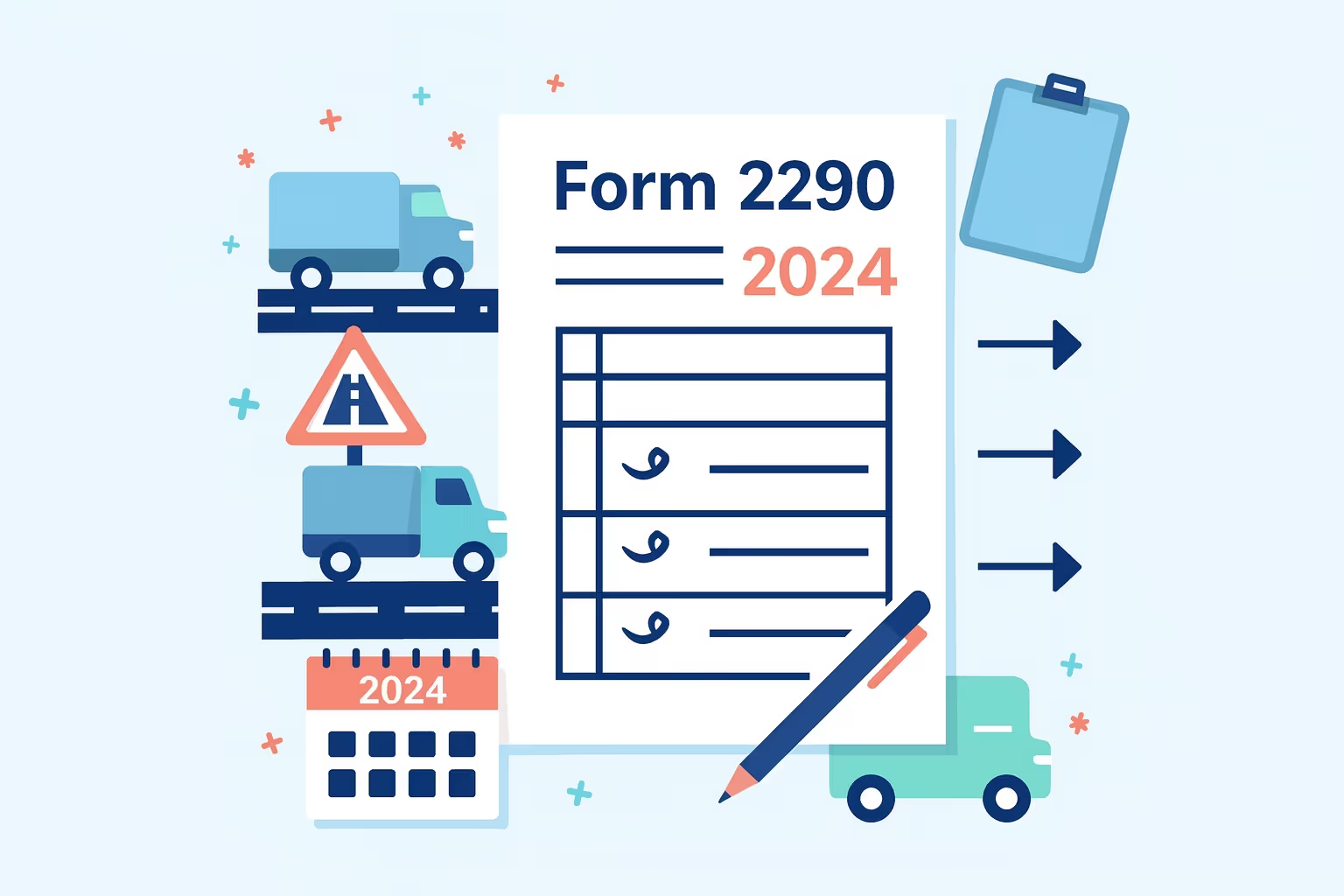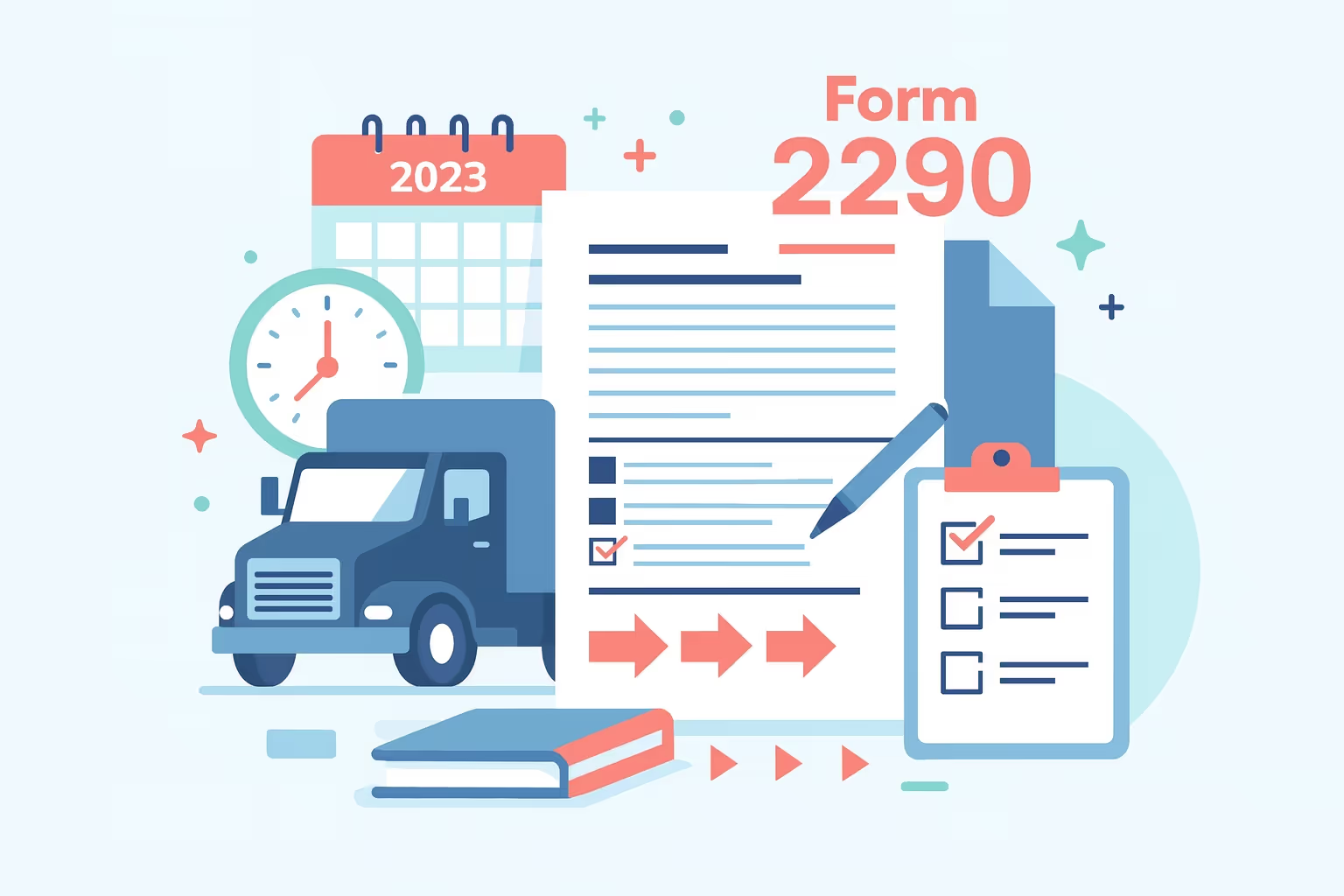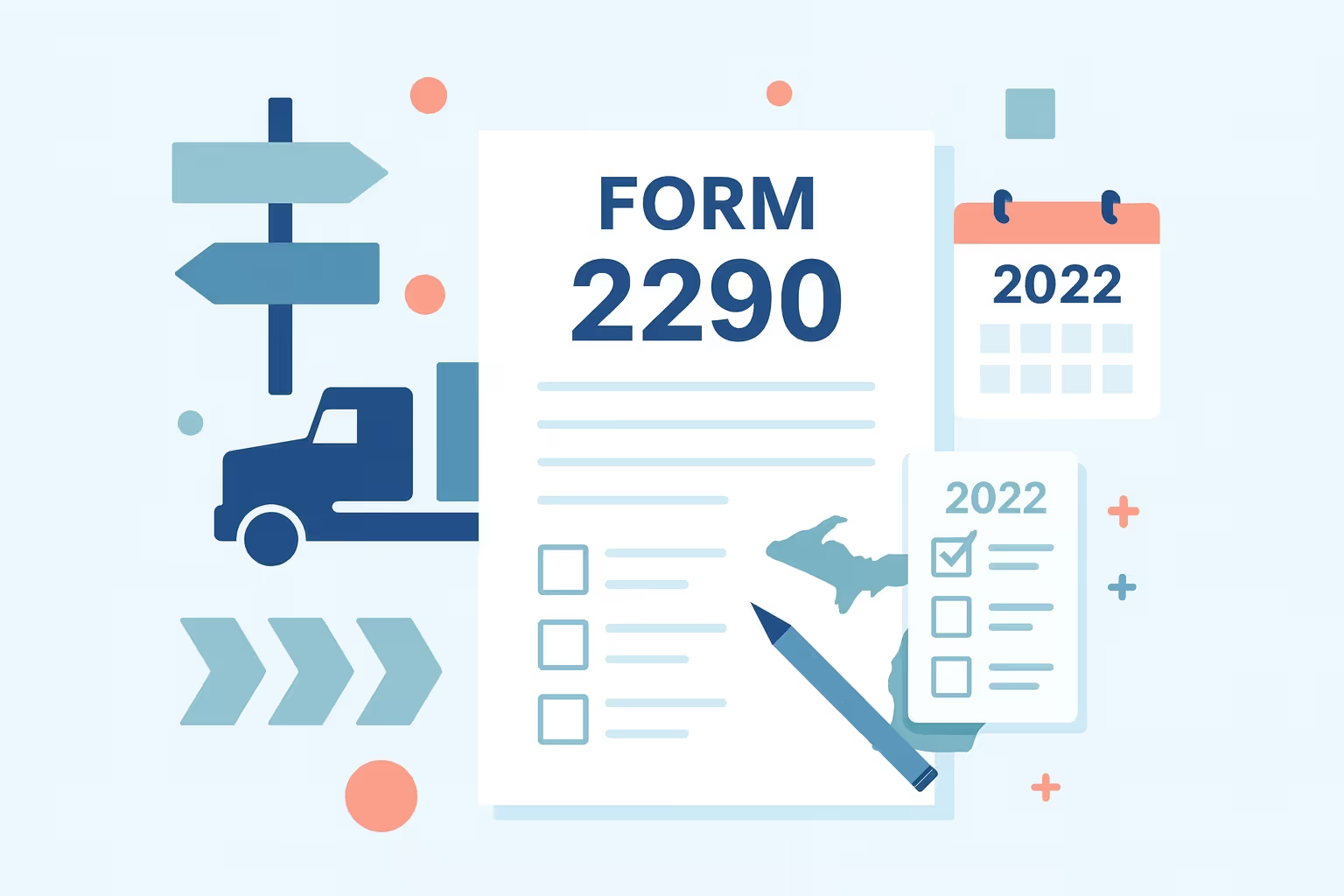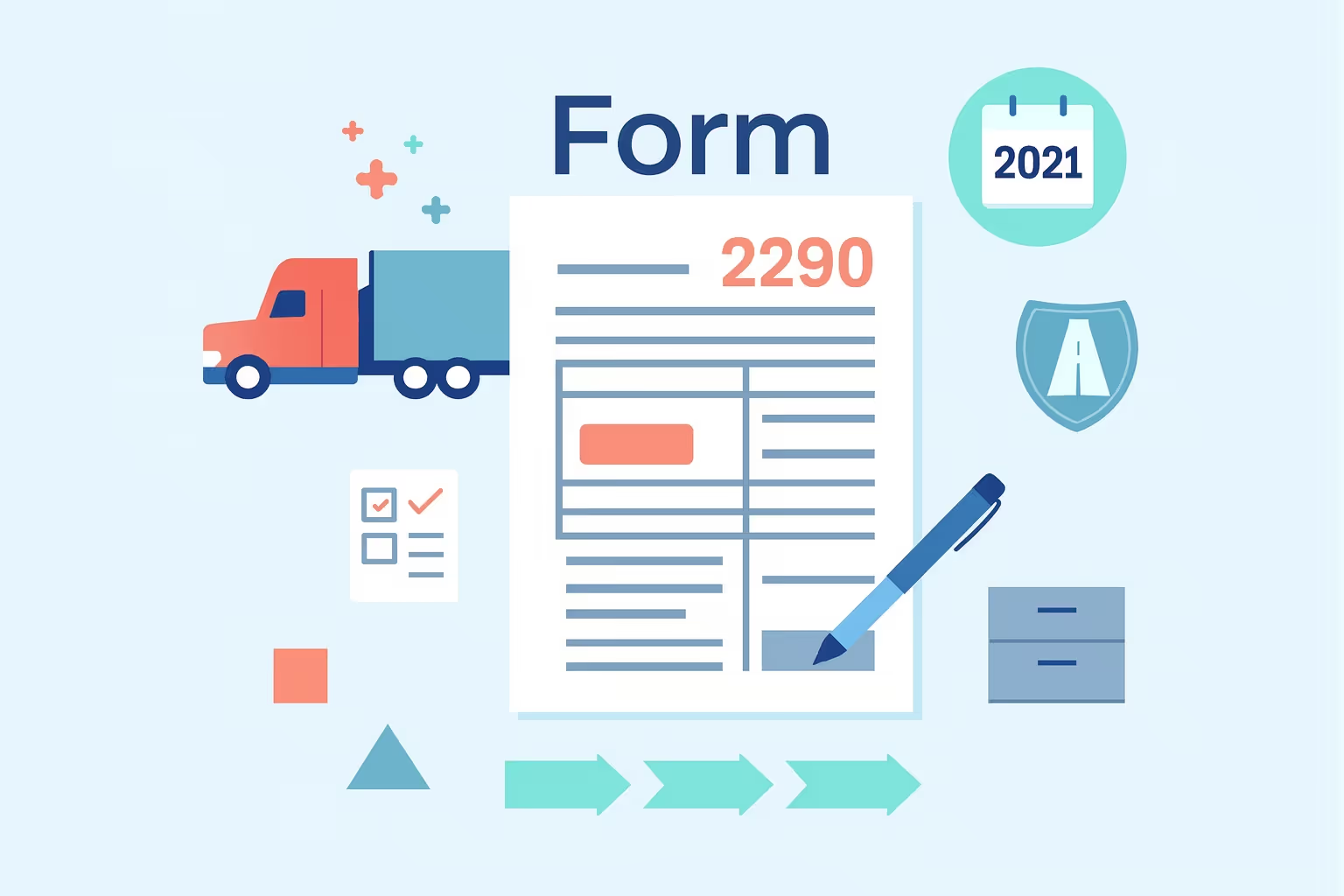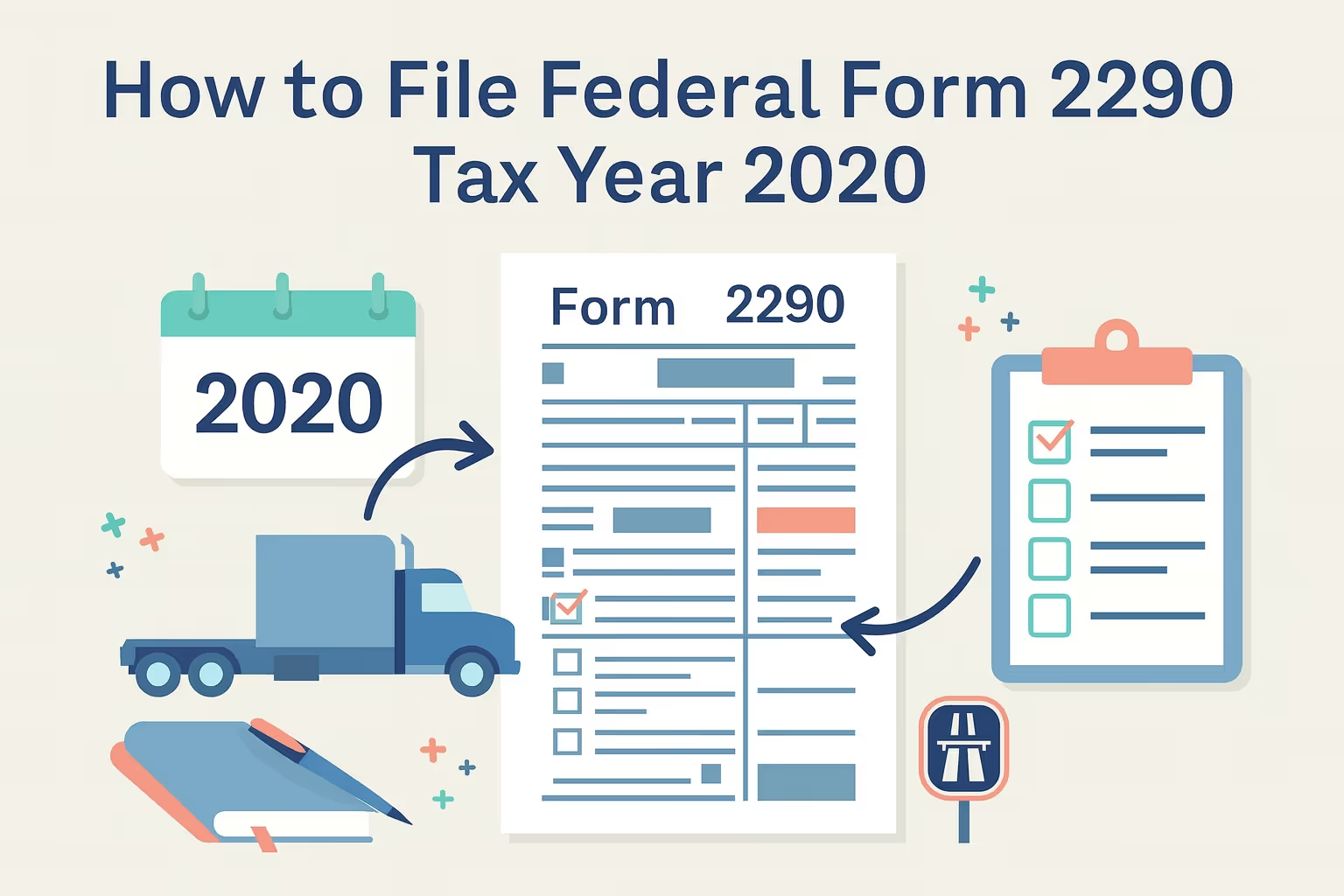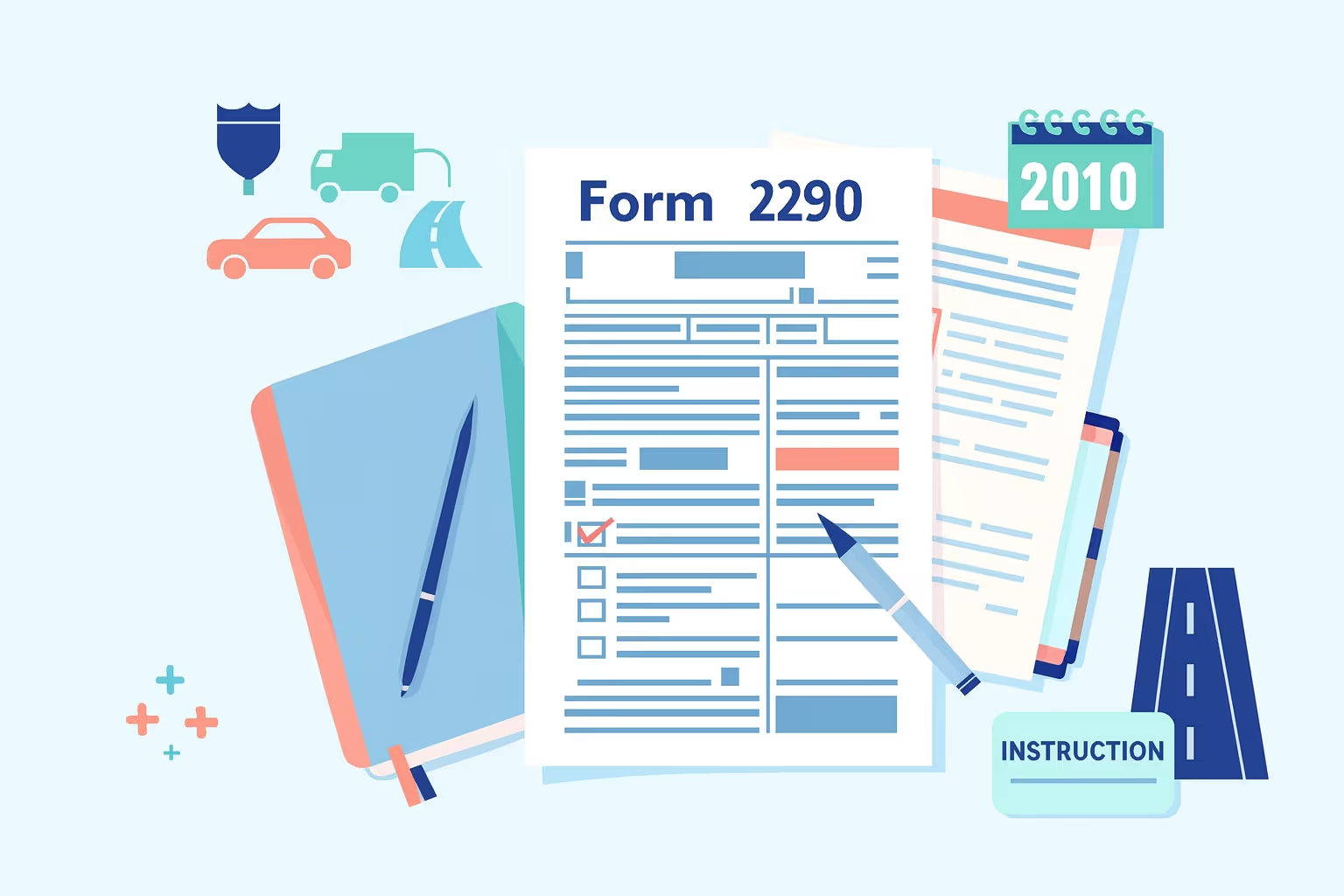Form 2290 2011 Instructions: IRS Heavy Vehicle Tax Return
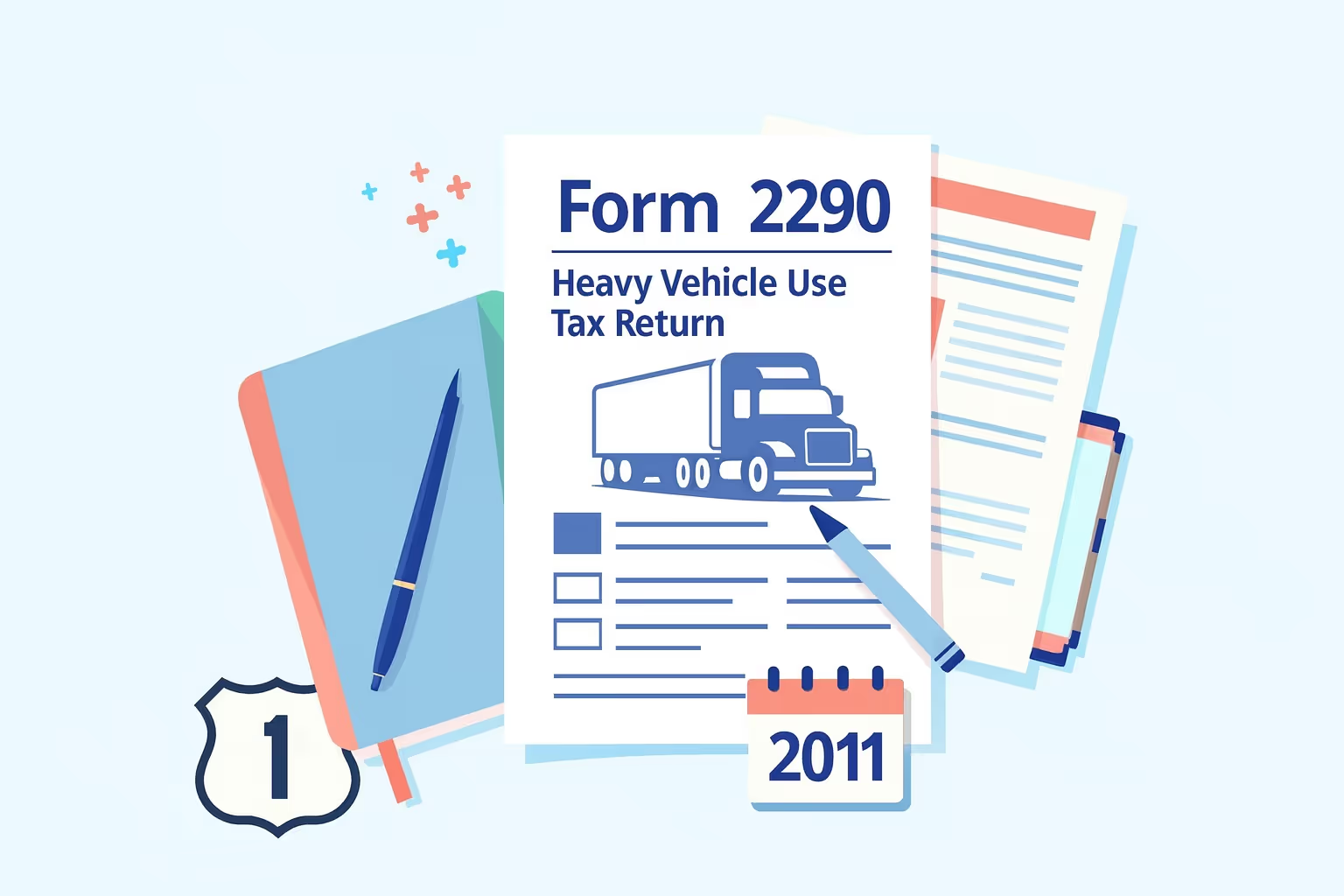
The Federal Internal Revenue Service requires Form 2290 as an annual filing for owners and operators of highway motor vehicles with registered gross weights equal to or exceeding 55,000 pounds. The 2011 tax period, which spans from July 1, 2011, to June 30, 2012, applies to heavy vehicles operating on public highways. The heavy vehicle use tax collected through this use tax return helps the federal government distribute revenues that fund highway construction, maintenance projects, and transportation improvements.
Taxpayers must ensure accurate reporting of each vehicle’s category, registered gross weights, and operational details. Vehicles operating below the mileage use limit may qualify for exemption or claim suspension if they remain within the expected threshold for the current period. Owners of a used taxable vehicle or one that moves into a new weight category must update their filing promptly to maintain compliance with the law. Proper reporting verifies taxes paid and ensures continued access to DMV registration and related services.
The IRS Trucking Tax Center provides detailed guidance on preparing a use tax return, meeting filing requirements, and confirming exemption eligibility. This official resource provides clear information for taxpayers seeking to electronically file and maintain accurate records for annual federal highway tax compliance.
Understanding the Heavy Vehicle Use Tax
The Heavy Vehicle Use Tax applies to highway motor vehicles operating on public highways that meet specific weight thresholds as defined by the Federal Internal Revenue Service. The Federal Internal Revenue Service uses funds from this annual requirement to support highway construction, maintenance projects, and safety improvements. Each taxpayer must file a use tax return, specifying the correct vehicle category, registered gross weight, and operating status, to confirm payment and remain compliant.
What the Heavy Vehicle Use Tax Covers
- Applies to highway motor vehicles used to transport goods, equipment, or passengers on public highways.
- Covers heavy vehicles operating within the United States during the current period that weigh 55,000 pounds or more.
- Requires taxpayers to submit a use tax return and confirm payment before receiving approval for motor vehicle registration.
- Supports federal government infrastructure service projects that sustain and expand the national highway system.
- Ensures that taxpayers contributing to road usage help fund future transportation development.
Who Must File a Use Tax Return
- Taxpayers who own or operate highway motor vehicles with registered gross weights equal to or exceeding 55,000 pounds.
- Businesses managing heavy vehicles operating across multiple districts or states under the federal highway network.
- Individuals responsible for a taxable vehicle acquired during the current tax year must report it immediately.
- Operators whose vehicle increases in weight during service and fall into a new category are subject to higher tax.
- Entities seeking to demonstrate full compliance with federal government tax regulations must ensure that all commercial operations comply with applicable filing, reporting, and recordkeeping requirements.
Exemptions and Special Categories
- Vehicles exempt from this requirement include those owned by the federal government, state agencies, or qualified blood collection organizations.
- Taxpayers may claim suspension if a vehicle is expected to remain under the mileage use limit of 5,000 miles or 7,500 miles for agricultural vehicles.
- Exemption eligibility depends on accurate figures showing limited mileage or specialized use within the current period.
- Heavy vehicles operating exclusively off-highway or in limited service may also qualify for exemption.
- All exemption or suspension claims must be documented clearly to verify expected operational limits.
Purpose and Allocation of Revenues
- Revenue funds highway construction, maintenance projects, and expansions of public infrastructure services.
- The federal government allocates these revenues to sustain highway improvements and safety programs.
- Each tax payment contributes directly to maintaining the federal highway system used by heavy vehicles operating nationwide.
Understanding the heavy vehicle use tax helps taxpayers determine their reporting obligations and comply with the Internal Revenue Service's federal requirements. Building familiarity with these rules fosters confidence during the filing process and helps prevent issues with vehicle registration. This knowledge prepares taxpayers to move forward with the next steps in completing their annual federal highway tax return.
2011 Filing Requirements and IRS Updates
The Federal Internal Revenue Service introduced several filing updates during the 2011 tax period that affected all taxpayers responsible for highway motor vehicles. Each update focused on improving reporting accuracy, expanding electronic access, and strengthening oversight for heavy vehicles operating under the annual federal highway program. Understanding these changes ensures that taxpayers remain compliant and submit a complete use tax return that accurately reflects the information for the current period.
IRS Changes for the 2011 Filing Year
The IRS expanded Schedule 1 to accommodate additional vehicles on a single return. This update allowed large operators managing heavy vehicles operating across multiple districts to consolidate their filings. Taxpayers were required to complete both copies of Schedule 1, as one served as proof of tax paid for DMV registration.
Electronic filing became mandatory for taxpayers reporting 25 or more vehicles. Those operating smaller fleets were also encouraged to file electronically as soon as possible. The enhancements continue to reduce clerical errors in use tax return submissions through electronic filing.
Early Filing Restrictions
Taxpayers were prohibited from submitting filings before November 1, 2011, to align with updates to the IRS system. Returns submitted early were not processed, and stamped Schedule 1 copies were unavailable until the official start date. This measure prevented confusion between prior and current period filings, maintaining uniformity in processing dates for federal government records.
The updated deadline applied specifically to vehicles first used in July, August, or September 2011. Taxpayers who became liable for heavy vehicle use tax within those months were required to file during November 2011. The tax figure reflected a complete 12-month calculation under the revised schedule.
Mileage and Exemption Adjustments
The IRS reaffirmed the mileage use limit thresholds for standard and agricultural vehicles. Regular vehicles remained subject to the 5,000-mile cap, while agricultural vehicles retained the 7,500-mile limit. Vehicles expected to stay within these limits may be eligible for suspension under qualifying exemption provisions.
Taxpayers were required to monitor their mileage throughout the current period closely. Any vehicle exceeding its mileage threshold became taxable and required an amended use tax return. Maintaining accurate figures ensured the correct classification for each vehicle and prevented reporting discrepancies.
Familiarity with these 2011 IRS updates supports compliance and accurate reporting for all taxpayers managing highway motor vehicles. Understanding the applicable deadlines, exemptions, and filing limits strengthens readiness for completing the next steps of the Form 2290 process.
Step-by-Step Guide to Completing IRS Form 2290
Completing IRS Form 2290 requires accuracy and attention to detail to ensure all information aligns with Federal Internal Revenue Service requirements. Each taxpayer must gather essential details about their highway motor vehicles, determine eligibility for exemption or claim suspension, and confirm the correct tax payment based on registered gross weights. The following steps outline the process for preparing and reviewing Form 2290 for the 2011 tax period.
Step 1: Gather Required Information
Start by collecting your Employer Identification Number (EIN), as the IRS no longer accepts Social Security Numbers for business filings. Record the Vehicle Identification Number (VIN) for each taxable vehicle acquired or operated during the current period. Include the vehicle’s first-use date, taxable gross weight, and current category classification to ensure accurate filing.
Taxpayers needing a new EIN can submit an online application through the Small Business and Self-Employed Portal. This official IRS resource provides access to business registration, federal tax obligations, and other essential filing services.
Step 2: Determine Vehicle Classification
Identify whether each vehicle falls under taxable, suspended, or exempt status. Vehicles operating on public highways with registered gross weights equal to or exceeding 55,000 pounds are subject to the heavy vehicle use tax. Vehicles expected to remain within the mileage use limit may qualify for suspension, while those operated by federal government entities or qualified blood collector organizations may be exempted.
Step 3: Calculate the Tax Payment
Use the official IRS tax computation tables to calculate the amount due based on each vehicle’s weight category and first-use month. Include adjustments if a vehicle’s weight increases during the year and moves into a new category. Ensure calculations reflect accurate figures to maintain compliance and avoid reprocessing.
Step 4: Complete Schedule 1
List all applicable vehicles on Schedule 1, ensuring each VIN and weight category is correctly entered. Complete both copies of Schedule 1; the IRS returns one stamped copy as proof of payment. This proof is required for DMV registration and renewal of vehicle operating authority.
Step 5: Review, Sign, and Submit the Return
Verify every entry for accuracy, ensuring all EINs, VINs, and weight details are complete. Sign and date the form before submission to confirm taxpayer responsibility. Attach Form 2290-V if paying by check or money order, and include the payment with the return when filing by mail.
Completing these steps accurately helps taxpayers maintain compliance with federal requirements and supports the timely processing of their annual federal highway filings. Thorough preparation strengthens record accuracy and ensures continued access to registration and operating privileges.
How to File: E-File and Paper Use Tax Return Options
Taxpayers filing IRS Form 2290 for the 2011 tax period may choose between electronic and paper submissions. Both filing methods meet federal requirements under the Federal Internal Revenue Service. The appropriate option depends on the number of vehicles, preferred filing method, and processing time requirements.
Electronic filing is strongly encouraged for heavy vehicles operating across multiple districts. It allows quick validation of information, faster acknowledgment, and secure data transmission. Paper filing remains an alternative for smaller fleets, although it typically requires a longer processing time before receiving proof of tax payment.
Comparison of Filing Methods
Electronic Filing (E-File)
- Key Features:
- Immediate confirmation of receipt
- Automatic validation to reduce errors
- Multiple payment options, including EFTPS and electronic funds withdrawal
- Best For: Businesses managing multiple highway motor vehicles
- Processing Time: Stamped Schedule 1 usually issued within 24 hours
- Proof of Tax Paid: Immediate access through electronic acknowledgment
- Additional Notes: Ideal for fleets operating in different districts where timely registration is critical
Paper Filing
- Key Features:
- Requires mailing Form 2290, Schedule 1, and Form 2290-V with payment
- Manual entry and physical documentation required
- Certified mail receipt should be included for recordkeeping
- Best For: Operators managing fewer than 25 vehicles
- Processing Time: Several weeks, depending on IRS mail processing
- Proof of Tax Paid: Stamped Schedule 1 mailed upon approval
- Additional Notes: More prone to clerical errors and delays compared to e-filing
Taxpayers may use the How to File Taxes Online page to access official electronic submission guidance. The resource outlines payment methods, eligibility requirements, and access to online filing. Reviewing these details helps taxpayers select an efficient and compliant submission process.
Each filing method satisfies heavy vehicle use tax requirements for the current period. E-filing supports larger operations that seek faster confirmation and secure processing, while paper filing suits smaller fleets that manage fewer vehicles. Choosing the appropriate option ensures compliance with federal government regulations, accurate proof of tax paid, and uninterrupted DMV registration.
Payment, Schedule 1 Proof, and Required Attachments
Filing IRS Form 2290 for the 2011 tax period requires accurate reporting, verified payment, and complete supporting documents. The Federal Internal Revenue Service will not process a use tax return without proof of tax paid and an attached Schedule 1. Each taxpayer must confirm that all required materials are included before submitting their return to maintain compliance with federal government standards.
- Payment Methods: Taxpayers may choose one of three approved options: Electronic Federal Tax Payment System (EFTPS), electronic funds withdrawal through e-filing, or check and money order with Form 2290-V. The payment must match the calculated heavy vehicle use tax based on registered gross weights and category. Timely payments ensure uninterrupted DMV registration and prevent delays in processing.
- Schedule 1 Proof: The stamped Schedule 1 serves as the official confirmation of tax paid under the annual federal highway program. DMV offices require this proof before allowing new registrations or renewals. Taxpayers should keep digital and paper copies to verify payment during audits or compliance reviews.
- Claiming Suspension: Taxpayers may claim suspension if a vehicle is expected to remain below the mileage use limit of 5,000 miles, or 7,500 miles for agricultural service. Records must clearly show that the vehicle operates within these limits during the current period. Vehicles exceeding thresholds become taxable immediately and require an amended use tax return.
- Exempt Vehicles: Some vehicles are exempt from heavy vehicle use tax, including those owned by the federal government, state agencies, and qualified blood collector organizations. Vehicles operating solely off-highway or used for non-transportation purposes may also qualify. Each exemption request must include written documentation that confirms the purpose and usage.
- Additional Attachments: Attachments must include detailed statements for sold or destroyed vehicles, credit claim records, and documentation supporting weight category changes. Taxpayers should submit accurate figures and signed forms explaining every adjustment. Missing or incomplete attachments can result in delayed processing or rejection of the return.
Preparing accurate payment records and attaching all required documents strengthens compliance and supports efficient IRS review. Thorough documentation ensures that taxpayers maintain access to vehicle registration and confirms full compliance with federal highway use tax obligations.
Recordkeeping, Credits, and Suspension Documentation
Taxpayers must maintain accurate and detailed records to support all figures reported on IRS Form 2290. Proper documentation ensures transparency and verification of tax paid, exemption claims, and eligibility for suspension. Organized recordkeeping also provides evidence during audits or reviews by the Federal Internal Revenue Service and supports compliance across multiple tax periods.
Recordkeeping Requirements
Every taxpayer must retain copies of all submitted forms, stamped Schedule 1 proofs, and payment confirmations for a minimum of three years. These records verify that each use tax return aligns with the annual federal highway requirements and confirms the status of heavy vehicles operating during the current period. Maintaining records beyond the minimum period may benefit taxpayers managing fleets across multiple districts or weight categories.
Supporting documentation should include mileage logs, vehicle identification numbers, and category classifications for each taxable vehicle acquired. Records must reflect any changes in registered gross weight or reclassification into a new vehicle category. Accurate logs strengthen a taxpayer’s ability to demonstrate compliance with mileage use limits and verify qualification for exemption or claim suspension.
Credit Eligibility and Requests
Taxpayers may request credits for vehicles that are destroyed, stolen, sold, or used within mileage limits that qualify for suspension. Each credit request must include supporting documents, such as the vehicle’s identification number, date of event, and proof of prior tax payment. Providing detailed evidence allows the federal government to allocate revenues properly and apply credit amounts to future filings.
Credits may also be applied when a vehicle's weight changes, resulting in a reclassification into a new category. Adjustments must include explanations that describe the shift and figures that demonstrate the status. Consistent reporting practices reduce the risk of processing errors and strengthen future eligibility for refund or credit claims.
Suspension Documentation
Taxpayers claiming suspension must maintain detailed mileage records showing that vehicles remain under the expected mileage use limit. These records should specify routes, dates, and operational purposes of each vehicle. Supporting logs validate compliance with federal government thresholds and prevent disputes during audits.
Accurate recordkeeping, supported credit claims, and clear suspension documentation help taxpayers maintain compliance and safeguard their reporting history. Taxpayers confirm eligibility, ensure accurate tax figures, and support consistent filing through proper documentation under the annual federal highway program.
Common Mistakes, Exemptions, and First-Time Filer Tips
Filing IRS Form 2290 for the first time requires careful preparation to avoid common mistakes and ensure compliance with federal regulations. New taxpayers often overlook essential requirements when reporting the operation of heavy vehicles across multiple districts. Understanding essential filing requirements helps taxpayers submit accurate information, meet deadlines, and maintain DMV registration and proof of payment.
1. Missing or Incomplete Schedule 1
Failure to attach both copies of Schedule 1 is one of the most frequent filing errors. The stamped copy is required to confirm tax paid and to finalize DMV registration. Every taxpayer must verify that Schedule 1 includes accurate Vehicle Identification Numbers and registered gross weights equal to IRS standards.
2. Using an Incorrect Identification Number
Taxpayers must use a valid Employer Identification Number rather than a Social Security Number. The Federal Internal Revenue Service requires EINs for all business filings to figure tax payment amounts correctly. Applying for an EIN early ensures timely filing and prevents rejection.
3. Misclassifying Weight Categories
Selecting an incorrect weight classification can result in an incorrect tax amount due. Taxpayers should verify the registered gross weights for each highway motor vehicle and confirm the accuracy of the category. Errors in classification may delay processing or create future adjustment requests.
4. Overlooking Exemption Eligibility
Some vehicles are exempted, including those owned by federal or state agencies and qualified blood collector organizations. Taxpayers should confirm whether their vehicle qualifies for an exemption or a mileage use suspension. Proper documentation must accompany every exemption request to verify eligibility.
5. Ignoring Filing Deadlines
Returns must be submitted by the last day of the month following the vehicle’s first use on public highways. Missing this deadline can delay confirmation of tax paid and affect DMV access. Marking deadlines and preparing filings in advance helps maintain compliance.
Avoiding these mistakes allows first-time filers to manage their reporting process effectively and meet federal government requirements. Reviewing documentation, verifying data accuracy, and understanding exemption qualifications ensures smooth filing. These practices strengthen taxpayer readiness for future filings under the annual federal highway program.
Frequently Asked Questions
What qualifies as a heavy highway vehicle under federal law?
A heavy highway vehicle is any truck, tractor, or bus registered for use on public roads with a taxable gross weight of 55,000 pounds or more. This figure includes the combined weight of the vehicle, trailers customarily used with it, and the maximum load typically carried. Vehicles meeting these thresholds must file Form 2290 and pay the annual highway vehicle use tax to remain compliant with federal regulations.
How is the highway vehicle use tax calculated for the current period?
The highway vehicle use tax is determined based on the vehicle’s taxable gross weight and the month it is first used during the tax year. Heavier vehicles and earlier first-use months generally result in a higher total fee. The Internal Revenue Service provides tables and guidance for computing the correct tax amount, ensuring that each taxpayer accurately reports the use of heavy highway vehicles.
Do I need to file Form 2290 for trailers or semi-trailers?
Form 2290 applies to heavy highway vehicles such as trucks and tractors, not to trailers or semi-trailers. However, when determining taxable gross weight, the unloaded weight of trailers customarily used with the vehicle must be included. This calculation ensures that registered gross weights accurately reflect the total vehicle configuration, which is necessary for proper reporting and fee assessment under the Highway Vehicle Use Tax program.
When does the tax period begin and end for the 2011 filing year?
The 2011 filing year covers the tax period from July 1, 2011, to June 30, 2012. Unlike a standard calendar year, this annual period aligns with the Federal Highway Use Tax cycle. Taxpayers must report any heavy highway vehicle first used within this timeframe and submit payment by the end of the month following the vehicle’s first use date on public highways.
Are any vehicles exempt from the heavy highway vehicle use tax?
Specific vehicles are exempt from the heavy highway vehicle use tax, including those owned by federal or state agencies, local governments, and qualified blood collector organizations. Additionally, vehicles used for less than 5,000 miles annually (7,500 miles for agricultural vehicles) may be eligible for suspension. Each exemption must be supported by documentation verifying mileage or ownership status to satisfy federal reporting requirements.
What if I acquire a used heavy highway vehicle during the tax year?
If a used taxable vehicle is acquired after the start of the tax period, the new owner must file Form 2290 and pay the applicable fee for the remaining months of the tax period. The filing must reflect the vehicle’s first month of use under the new ownership. This process ensures that the Federal Internal Revenue Service receives accurate information and maintains a valid tax-paid status for DMV registration.
Can I file and pay the highway vehicle use tax electronically?
Yes, taxpayers may electronically file Form 2290 through an IRS-authorized e-file provider. Taxpayers reporting 25 or more vehicles are required to file electronically, while others are encouraged to do so for faster processing and immediate confirmation. E-filing supports timely verification of tax paid and helps maintain continuous registration for heavy highway vehicles operating on public roads.
















